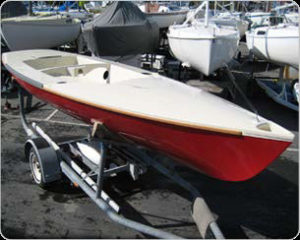 If you have been racing sailboats for any length of time, you know how difficult it is to maintain a fleet. If you are a member of a yacht club, you know that fleets come and go on a regular basis. If you own a boat and your fleet disappears, you are understandably frustrated and discouraged. If you are thinking about buying a boat, you may be wondering in the back of your mind how long the fleet will last. You may find yourself caught between trying to not to be negative, yet realizing that you have to be realistic at the same time.
If you have been racing sailboats for any length of time, you know how difficult it is to maintain a fleet. If you are a member of a yacht club, you know that fleets come and go on a regular basis. If you own a boat and your fleet disappears, you are understandably frustrated and discouraged. If you are thinking about buying a boat, you may be wondering in the back of your mind how long the fleet will last. You may find yourself caught between trying to not to be negative, yet realizing that you have to be realistic at the same time.
So, you take the plunge and buy a boat. Then, you discover that either you don’t enjoy racing the boat, don’t like the people in your fleet, or don’t have as much time as you thought to race the boat. Rather than selling the boat right away, you may keep the boat at the club and hope that things will change. If enough people do this, word gets around that the fleet is in trouble. Unfortunately, unless the situation changes, the fleet dies.
The boat owners are not the only losers. The yacht club is also a loser. The whole purpose of a yacht club is to promote yachting, of which sailboat racing is a big part. When a yacht club cannot maintain stable fleets, it reflects poorly on the club. Even though most members are aware that fleets come and go, when a fleet dies, it hurts club morale. The club can wind up with a fair number of boats in the yard which are not being raced, and attendance drops at club regattas.
Given their precarious nature, what does it take to make a fleet sustainable? The members of USITA Long Beach think they have the answer. In brief, the fleet uses the following strategy:
Everyone Gets a Chance to Improve Their Racing Skills
So what happens when you eliminate boat speed as a factor in deciding who wins, but some sailors are still not doing as well as they would like? The answer is you provide as much help as the sailor wants. The fleet is committed to the concept that the best racing occurs when everyone is racing at their best. Ideally, the fleet would start and finish as a group, with the lead constantly swapping hands until the end of the race. In more practical terms, if the fleet is too spread out at when the first boat finishes, the fleet has a problem that should be fixed.
As noted in other areas of this website, the fleet offers classes in:
- Boat-handling skills
- Sail trim and mast bending
- Racing tactics and strategy
- Racing rules
The classes are typically given by fleet members who are good in a specific area. A fleet member who has mastered the racing rules will give the seminar on racing rules. Another member who is particularly good at starts will give a class on getting a good start. These classes are open to the entire yacht club, not just members of the fleet. This makes the fleet an integral part of the club and attracts future members.
Getting the Whole Family Involved
Whenever only one member of the family is racing, this can put a strain on the family. The other family member may resent the time and commitment that their spouse is putting into an activity in which they are not involved. To counter this, the fleet schedules events which involve the entire family. These events include dinners during two-day regattas, special award ceremonies, or participating in running the races. The non-sailing spouse can help set marks, record scores and calculate the results, make videos of the racing, help to maintain the fleet website, select trophies, make T-shirts for the fleet, and help maintain the boats or plan social events.
Awarding Trophies of Equal Value to Skipper and Crew
Sailboat racing requires teamwork. The best way to recognize this teamwork is to award trophies of equal value to both skipper and crew. To make sure this happens at club-sponsored regattas, every member of the fleet must pay a higher entry fee. The additional fee is worth it. Just imagine what will happen at the awards ceremony following the regatta. All winners in the Tempest class will be awarded two, identical trophies. Every other class will get one. This presents a very positive image for the class.
So, there you have the winning formula to running a sustainable fleet. Look around. How many fleets do you see using this approach? The answer is not too many. Perhaps this is why fleets come and go so quickly.
